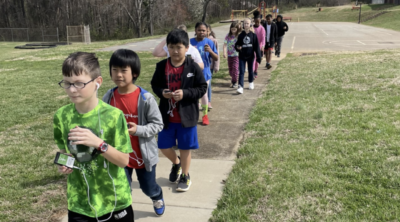This post, part of our Walk This Way series, shares The Walking Classroom experiences of teachers and students across the United States. This post provides a glimpse into Kim Collazo’s class.
When recently surfing my Twitter feed, I came across a conversation with educators participating in the #newselachat. A question posed inquired, “How often should students move? Why?”
Movement Sparks Brain Activity
Dr. Joe Mazza, a well-known principal in New York, responded with an excellent graphic depicting two brain scans. One, lit up in blues and greens, had the caption, “Brain after Sitting Quietly.” The other showed the tell-tale reds, oranges, and yellows. This one, indicating increased amounts of activity, had the caption, “Brain after a 20-Minute Walk.”
Of course, I immediately thought of the Walking Classroom. This simple graphic relates one of the fundamental reasons our Walking Club plays such a vital part in our STEM program!
 A Sluggish Start Remedied by A Brisk Walk!
A Sluggish Start Remedied by A Brisk Walk!
The Walking Club (made up of fifteen fourth graders) visits the STEM lab first thing every Wednesday morning. Many times the students are yawning, dragging their feet, and displaying other signs that their brains are still in the “green and blue zone.” Beginning the morning trying to engage in academic tasks while in this state is not optimal.
However, in stark contrast, after a brisk walk, students have increased energy. Their conversation includes many interesting observations, and they have not lost any academic time. As a matter of fact, while increasing the oxygen and blood flow to their brains (picture the “red and yellow zone” from the earlier-described graphic), they have just learned at least six or eight new content facts, enhancing their science schema!
Benefits Beyond Movement
In addition to the health benefits of the walk itself, the program provides interesting and relevant health information at the beginning of each podcast. The importance of this was brought to light today during our weekly walk and discussion.
 I had spent the first fifteen minutes of the day in one of our fourth grade teacher’s classrooms observing her Morning Meeting. She asked, “Would you rather go skydiving or scuba diving?” A robust conversation ensued. As luck would have it, our student-selected podcast for our Walking Club just ten minutes later was Marine Life (5-#76, STEM-#34, Complete-#142).
I had spent the first fifteen minutes of the day in one of our fourth grade teacher’s classrooms observing her Morning Meeting. She asked, “Would you rather go skydiving or scuba diving?” A robust conversation ensued. As luck would have it, our student-selected podcast for our Walking Club just ten minutes later was Marine Life (5-#76, STEM-#34, Complete-#142).
The entire beginning of the podcast focuses on the advantages of water exercise. It tells how activity like snorkeling or swimming, helps to avoid harmful impact to human joints.
Everything was Interconnected!
How timely! We easily continued the discussion from the students’ morning meeting when they had discussed scuba diving and what you might see in the depths of the ocean. Everything was interconnected from health benefits to marine life. And, my students did better on the podcast quiz than on any other they’d taken so far this year!
As you can tell, the health benefits associated with The Walking Classroom include not only the movement that comes from the walk itself. Often, they include much more! Happy Trails!
Kim Collazo
STEM Coordinator
Robbins Elementary





Leave a Reply